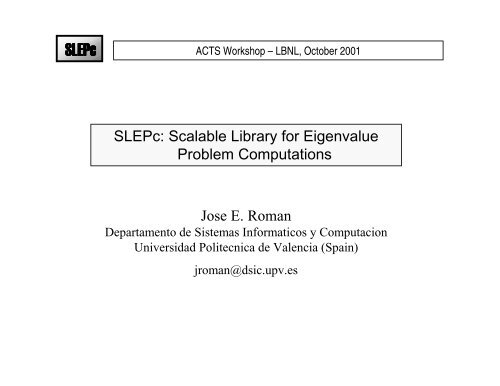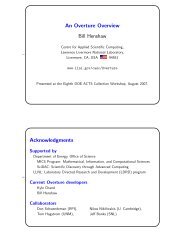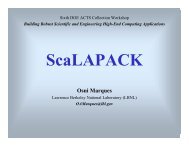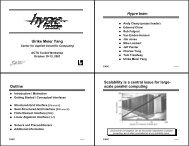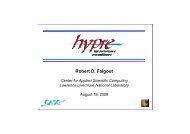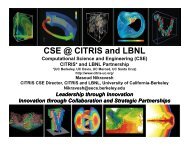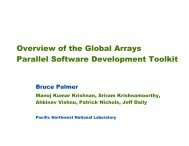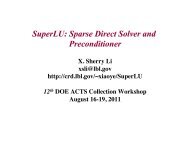SLEPc: Scalable Library for Eigenvalue Problem Computations Jose ...
SLEPc: Scalable Library for Eigenvalue Problem Computations Jose ...
SLEPc: Scalable Library for Eigenvalue Problem Computations Jose ...
Create successful ePaper yourself
Turn your PDF publications into a flip-book with our unique Google optimized e-Paper software.
<strong>SLEPc</strong><br />
<strong>SLEPc</strong> ACTS Workshop – LBNL, October 2001<br />
<strong>SLEPc</strong>: <strong>Scalable</strong> <strong>Library</strong> <strong>for</strong> <strong>Eigenvalue</strong><br />
<strong>Problem</strong> <strong>Computations</strong><br />
<strong>Jose</strong> E. Roman<br />
Departamento de Sistemas In<strong>for</strong>maticos y Computacion<br />
Universidad Politecnica de Valencia (Spain)<br />
jroman@dsic.upv.es
<strong>SLEPc</strong><br />
<strong>Problem</strong> Definition<br />
• Target problems<br />
– Large sparse eigenvalue problems<br />
– Example: discretization of PDEs<br />
• Types of problems<br />
– Standard: Ax=λx<br />
– Generalized: Ax=λBx<br />
– Other (SVD, quadratic, …) <strong>for</strong>mulated as one of the above<br />
• Methods<br />
– “Direct” methods (QR, Jacobi, etc.) are not appropriate<br />
– Vector iterations<br />
• Single vector iterations (power, inverse iteration, RQI)<br />
• Multiple vector iterations (subspace iteration, block RQI)<br />
• Projection methods (Arnoldi, Lanczos, Jacobi-Davidson)<br />
– Acceleration techniques: spectral trans<strong>for</strong>mations
<strong>SLEPc</strong><br />
Acceleration<br />
• Convergence rate is critical <strong>for</strong> good per<strong>for</strong>mance<br />
– Clustered eigenvalues are a problem<br />
– Acceleration techniques usually aim at improving separation<br />
• Polynomial filtering<br />
– Chebychev, least-squares and other polynomials<br />
– The optimal polynomial is difficult to obtain<br />
• Spectral trans<strong>for</strong>mations<br />
– Origin shift: improvement is very limited<br />
– Shift-and-invert:<br />
• Very effective technique, widely used<br />
• Also allows to find internal eigenvalues<br />
– More general trans<strong>for</strong>ms: Cayley, rational<br />
– Can be combined with any solution method<br />
(A-σI) -1 x=µx<br />
(A-σB) -1 Bx=µx
<strong>SLEPc</strong><br />
Available Software<br />
• Parallel eigenvalue solvers<br />
– PARPACK (Sorensen, Lehoucq et al)<br />
• Implicitly Restarted Arnoldi/Lanczos method<br />
• Symmetric and nonsymmetric<br />
• Real and complex problems<br />
– BLZPACK (Marques)<br />
• Block Lanczos method<br />
• For complex problems use HLZPACK<br />
– PLANSO (Parlett/Wu and Simon)<br />
• Lanczos with partial reorthogonalization<br />
– TRLAN (Wu and Simon)<br />
• Dynamic thick-restart Lanczos algorithm<br />
• Linear systems of equations<br />
– Direct methods: SuperLU, PSPASES, SPOOLES, (PETSc)<br />
– Iterative methods: PETSc, Aztec, PIM, Isis++, …
<strong>SLEPc</strong><br />
<strong>SLEPc</strong> Objectives<br />
• Current situation<br />
– Software <strong>for</strong> eigenvalue problems available<br />
– Traditional programming model (Fortran, reverse<br />
communication, etc)<br />
– User has to be aware of details of parallelism<br />
– Usually has to be combined with software <strong>for</strong> the solution of<br />
linear systems of equations<br />
• With <strong>SLEPc</strong><br />
– More modern programming paradigm<br />
• Object oriented<br />
• Built-in programming tools: debugging, visualization, etc.<br />
• Details of parallelism hidden in lower abstraction levels<br />
– Very easy to implement an eigensolver<br />
• The user still has control over all the details of solution method<br />
– All the functionality of PETSc available
<strong>SLEPc</strong><br />
What is <strong>SLEPc</strong>?<br />
• <strong>SLEPc</strong>: <strong>Scalable</strong> <strong>Library</strong> <strong>for</strong> <strong>Eigenvalue</strong> <strong>Problem</strong> <strong>Computations</strong><br />
• A new library<br />
– Aim: solution of large scale sparse eigenvalue problems<br />
– Can be considered an extension of PETSc<br />
– Developed by HPNC group in Valencia (Spain)<br />
• Properties<br />
– Freely available (and supported) research code<br />
– Hyperlinked documentation and manual pages <strong>for</strong> all routines<br />
– Many tutorial-style examples<br />
– (Support via email)<br />
– Usable from Fortran 77/90, C, and C++<br />
– Portable to any parallel system supporting MPI<br />
– Good parallel per<strong>for</strong>mance<br />
– Extensible<br />
… the same way as PETSc
<strong>SLEPc</strong><br />
Numerical Components<br />
Nonlinear Solvers<br />
PETSc<br />
Time Steppers<br />
<strong>SLEPc</strong><br />
Eigensolvers<br />
Newton-based Methods<br />
Line Search<br />
Trust Region<br />
Other<br />
Euler<br />
Backward<br />
Euler<br />
Pseudo Time<br />
Stepping<br />
Other<br />
Power RQI SI Arnoldi<br />
Lanczos Arpack Blzpack Other<br />
Krylov Subspace Methods<br />
GMRES CG CGS Bi-CG-STAB TFQMR Richardson Chebychev Other<br />
Spectral Trans<strong>for</strong>m<br />
Shift Shift-and-invert Other<br />
Preconditioners<br />
Additive<br />
Schwartz<br />
Block<br />
Jacobi<br />
Jacobi ILU ICC<br />
LU<br />
(Sequential only)<br />
Others<br />
Matrices<br />
Compressed<br />
Sparse Row<br />
(AIJ)<br />
Blocked Compressed<br />
Sparse Row<br />
(BAIJ)<br />
Block<br />
Diagonal<br />
(BDIAG)<br />
Dense<br />
Other<br />
Vectors<br />
Index Sets<br />
Indices Block Indices Stride Other
<strong>SLEPc</strong><br />
<strong>SLEPc</strong> <strong>SLEPc</strong> objects (1)<br />
EPS: <strong>Eigenvalue</strong> <strong>Problem</strong> Solver<br />
• Solvers <strong>for</strong><br />
– Standard and generalized<br />
– Real and complex arithmetic<br />
– Hermitian and non-Hermitian<br />
• Main functions<br />
– EPSCreate, EPSDestroy, EPSView, EPSSetOperators,<br />
EPSSetInitialVector, EPSSetUp, EPSSolve<br />
• The user can<br />
– Select a solver<br />
– Specify various parameters:<br />
• nev: number of eigenvalues<br />
• ncv: dimension of the subspace (number of basis vectors)<br />
• tolerance, max iterations, portion of the spectrum<br />
• orthogonalization technique (CGS, MGS, IR, DGKS, other)<br />
• whether to compute eigenvectors or not<br />
– Via procedural or command line interface
<strong>SLEPc</strong><br />
<strong>SLEPc</strong> <strong>SLEPc</strong> objects (2)<br />
ST: Spectral Trans<strong>for</strong>mation<br />
• How it works<br />
– Solvers apply the “operator” to a vector<br />
– The “operator” is different<br />
depending on the type of ST<br />
– Linear systems are handled<br />
via a SLES object<br />
– After convergence, eigenvalues<br />
have to be trans<strong>for</strong>med back appropriately<br />
• Main functions<br />
– STCreate, STDestroy, STView, STSetUp, STApply<br />
• The user can<br />
Standard Generalized<br />
none A B -1 A<br />
shift A+σI B -1 Α+σI<br />
sinvert (A-σI) -1 (A-σΒ) -1 B<br />
– Select the type of trans<strong>for</strong>mation<br />
• Type shell also available <strong>for</strong> user-defined trans<strong>for</strong>mations<br />
– Specify various parameters: the value of the shift (σ)<br />
– In sinvert also the linear system solver and corresponding options
<strong>SLEPc</strong><br />
Basic Eigensolver Code<br />
EPS eps; /* eigensolver context */<br />
Mat A; /* matrix */<br />
Vec *x; /* basis vectors */<br />
Scalar *kr,*ki; /* eigenvalues */<br />
MatCreate(MPI_COMM_WORLD,n,n,N,N,&A);<br />
MatSetFromOptions(A);<br />
/* assemble matrix */<br />
EPSCreate(MPI_COMM_WORLD,&eps);<br />
EPSSetOperators(eps,A,PETSC_NULL);<br />
EPSSetFromOptions(eps);<br />
EPSSolve(eps,&its);<br />
EPSGetConverged(eps,&nconv);<br />
EPSGetSolution(eps,&kr,&ki,&x);<br />
EPSComputeError(eps,error);
<strong>SLEPc</strong><br />
Power Method<br />
• power<br />
– Power method<br />
– Deflation <strong>for</strong> computing more than one eigenpair<br />
– Combined with shift-and-invert is equivalent to inverse<br />
iteration<br />
• rqi<br />
– Rayleigh Quotient Iteration<br />
– Only implemented <strong>for</strong> one eigenpair<br />
• Examples<br />
ex1 –eps_type power –eps_tol 1e-8 –eps_monitor<br />
ex1 –eps_type power –eps_nev 6<br />
ex1 –eps_type power –st_type shift –st_shift 0.5<br />
ex1 –eps_type power –st_type sinvert –st_shift 2000<br />
ex1 –eps_type rqi –eps_monitor_values
<strong>SLEPc</strong><br />
Subspace Iteration<br />
• subspace<br />
– Subspace Iteration method<br />
– Non-Hermitian projection<br />
– Deflation by locking converged eigenpairs<br />
• Examples<br />
ex1 –eps_type subspace –eps_nev 1 –eps_ncv 12<br />
ex1 –eps_type subspace –eps_mgs_orthog<br />
ex1 –eps_type subspace –eps_plot_eigs –draw_pause 10<br />
ex1 –eps_type subspace –st_type sinvert –st_shift 1<br />
–sinv_ksp_type gmres –sinv_pc_type sor<br />
–sinv_pc_sor_omega 1.2<br />
ex1 –eps_type subspace -none_ksp_type cg<br />
–none_pc_type jacobi –none_ksp_tol 1e-5<br />
ex1 –eps_type subspace –eps_view
<strong>SLEPc</strong><br />
Arnoldi, Lanczos and Wrappers<br />
• arnoldi<br />
– Arnoldi method<br />
– Explicit restart and deflation<br />
• lanczos<br />
– (Hermitian) Lanczos method<br />
– Full reorthogonalization<br />
• Wrappers<br />
– arpack, blzpack, planso, trlan<br />
– Specific options <strong>for</strong> some of them,<br />
e.g. -eps_blzpack_block_size<br />
– Also lapack <strong>for</strong> validation purposes<br />
– When installing <strong>SLEPc</strong> the user specifies which of this<br />
packages are available
<strong>SLEPc</strong><br />
Examples<br />
Category Filename Description<br />
1 ex1.c 1-D Laplacian, standard symmetric eigenproblem<br />
3 ex1f.F Fortran equivalent of ex1.c<br />
1 ex2.c 2-D Laplacian, standard symmetric eigenproblem<br />
4 ex3.c 2-D Laplacian, matrix-free version<br />
1 ex4.c Matrix loaded from a file, standard problem<br />
1 ex5.c Markov model of a random walk in a triangular grid<br />
9 ex6f.F Ising model <strong>for</strong> ferromagnetic materials<br />
1 ex7.c Matrices loaded from a file, generalized problem<br />
6 ex8.c Grcar matrix, Singular Value Decomposition<br />
1 ex9.c Brusselator model, standard nonsymetric w/blocks<br />
Also tests with NEP collection (math.nist.gov/MatrixMarket)
<strong>SLEPc</strong><br />
The Future<br />
• First version:<br />
– Will probably be released in Nov or Dec 2001<br />
– Version numbering will probably be consistent with PETSc<br />
• There<strong>for</strong>e: <strong>SLEPc</strong> 2.1.0<br />
– Will contain<br />
• Power, Subspace iteration, RQI, Arnoldi, Lanczos<br />
• Also wrappers to Arpack, Blzpack, Planso, Trlan, Lapack<br />
• Shift and shift-and-invert spectral trans<strong>for</strong>mations<br />
• What is next?<br />
– Close collaboration with PETSc team<br />
– More methods (Non-Hermitial Lanczos, Jacobi-Davidson, …)<br />
– Other spectral trans<strong>for</strong>mations or acceleration techniques<br />
– Further testing with several case studies<br />
• Open to external collaboration<br />
– Researchers who want to experiment with new methods<br />
– Users with interesting applications
<strong>SLEPc</strong><br />
Lambda Modes<br />
• Nuclear reactor analysis<br />
• The Lambda Modes equation<br />
• Modeling the reactor<br />
• Solution strategy<br />
• Implementation with <strong>SLEPc</strong><br />
• Preliminary per<strong>for</strong>mance results
<strong>SLEPc</strong><br />
Introduction<br />
• Context: Security analysis in nuclear reactors<br />
– The main aim is to improve security<br />
– Also reduction of production costs can be pursued<br />
– Engineering companies demand tools <strong>for</strong> detailed analysis<br />
– This analysis has evolved to 3D methodologies<br />
Study of Nuclear Reactors<br />
Where neutrons are located<br />
Criticality of the reactor<br />
(Neutron Diffusion Equation)<br />
Steady Analysis<br />
(Lambda Modes)<br />
Transient Analysis<br />
• Lambda Modes analysis<br />
– eigenvalues and eigenvectors of time-independent neutron<br />
diffusion equation of a nuclear reactor
<strong>SLEPc</strong><br />
Criticality<br />
Criticality: depends on how many of the free neutrons from each<br />
fission, on average, hits another U-235 nucleus and causes it to<br />
split:<br />
• Exactly one: the mass is critical<br />
– The mass will exist at a stable temperature<br />
• Less than one: the mass is subcritical<br />
– Eventually, induced fission will end in the mass<br />
• More than one: the mass is supercritical<br />
– It will heat up<br />
– In a nuclear reactor, the reactor core needs to be slightly<br />
supercritical so that plant operators can raise and lower the<br />
temperature of the reactor<br />
– The control rods give the operators a way to absorb free neutrons<br />
so that the reactor can be maintained at a critical level
<strong>SLEPc</strong><br />
The Physical <strong>Problem</strong><br />
• Lambda Modes equation<br />
– Derived from time-independent neutron diffusion equation<br />
– Multigroup approach: neutrons are grouped in energy<br />
intervals. With two energy groups (fast and thermal):<br />
L<br />
=<br />
⎡− ∇<br />
⎢<br />
⎣<br />
M<br />
=<br />
( D ∇)<br />
+ Σ<br />
1<br />
⎡v<br />
⎢<br />
⎣<br />
1<br />
− Σ<br />
Σ<br />
0<br />
f 1<br />
Lφ<br />
=<br />
12<br />
i<br />
a1<br />
v<br />
2<br />
+ Σ<br />
Σ<br />
0<br />
1<br />
Mφi<br />
λ<br />
f<br />
i<br />
2<br />
12<br />
⎤<br />
⎥<br />
⎦<br />
− ∇(<br />
D<br />
φ =<br />
i<br />
2<br />
0<br />
∇)<br />
⎡φ<br />
fi<br />
⎢<br />
⎣φti<br />
+ Σ<br />
⎤<br />
⎥<br />
⎦<br />
a2<br />
⎤<br />
⎥<br />
⎦
<strong>SLEPc</strong><br />
The Algebraic <strong>Problem</strong><br />
• Discretization: Nodal Collocation, with Legendre<br />
polynomials<br />
⎡ L<br />
⎢<br />
⎣−<br />
L<br />
11<br />
21 22<br />
0 ⎤⎡ψ<br />
1 ⎤ M M<br />
i<br />
1 ⎡<br />
L<br />
⎥⎢<br />
⎦⎣ψ<br />
⎥ =<br />
λ<br />
⎢<br />
2i<br />
⎦ i ⎣ 0 0<br />
• Reduced size eigenproblem<br />
Aψ<br />
1 i 1<br />
i<br />
λ ψ<br />
−1<br />
−1<br />
A= L ( M + M L L )<br />
11<br />
Lψ<br />
=<br />
i<br />
1<br />
Mψ<br />
i<br />
λ<br />
=<br />
i<br />
11 12 22<br />
i<br />
21<br />
⎤⎡ψ<br />
⎤<br />
i<br />
⎥⎢<br />
⎦⎣ψ<br />
⎥<br />
2i<br />
⎦<br />
11 12 1
<strong>SLEPc</strong><br />
Nodalization<br />
2D Case<br />
All axial planes are<br />
considered equal<br />
¼ symmetry<br />
3D Case<br />
Different axial planes<br />
No symmetries<br />
Other details such as<br />
control rods
<strong>SLEPc</strong><br />
Control Rods<br />
Bank No. of rods Purpose<br />
1 8 Security<br />
2 8 Security<br />
3 8 Security<br />
4 8 Security<br />
5 12 Regulation<br />
6 12 Regulation<br />
7 9 Regulation<br />
8 8 APSR<br />
The user can specify the position of each control rod bank<br />
(e.g. bank 7 inserted 20%)
<strong>SLEPc</strong><br />
Analysis of Results<br />
• Physical interpretation of results<br />
– <strong>Eigenvalue</strong>s in<strong>for</strong>m about criticality of the reactor<br />
– Eigenvectors in<strong>for</strong>m about distribution of power density<br />
1.4<br />
5<br />
D ensi d adde p otenci ȧ<br />
1.5<br />
1<br />
0.5<br />
0<br />
20<br />
15<br />
10<br />
Y<br />
5<br />
0<br />
0<br />
5<br />
X<br />
10<br />
15<br />
20<br />
1.2<br />
1<br />
0.8<br />
0.6<br />
0.4<br />
0.2<br />
0<br />
D ensi d adde p otenci ȧ<br />
6<br />
5<br />
4<br />
3<br />
2<br />
1<br />
0<br />
20<br />
15<br />
10<br />
Y<br />
5<br />
0<br />
0<br />
5<br />
X<br />
10<br />
15<br />
20<br />
4.5<br />
4<br />
3.5<br />
3<br />
2.5<br />
2<br />
1.5<br />
1<br />
0.5<br />
0<br />
normal conditions<br />
abnormal conditions
<strong>SLEPc</strong><br />
Nonzero Pattern (2D)<br />
L<br />
M<br />
L 11 ,L 22 : symmetric matrices, (almost always) positive definite<br />
M 11 ,M 12 ,L 21 : diagonal matrices
<strong>SLEPc</strong><br />
Solution Strategy<br />
• Large eigenvalue problem<br />
– Size in 3D models range from 50000 to 1 million depending on<br />
degree of polynomial<br />
– “Sparse” methods are preferred<br />
• Several approaches<br />
– Full eigensystem<br />
– Reduced generalized eigensystem<br />
– Reduced standard eigensystem<br />
• In the latter case, matrix vector products are done without<br />
<strong>for</strong>ming the matrix explicitly<br />
A ψ<br />
1 i 1<br />
i<br />
λ ψ<br />
−1<br />
−1<br />
A = L ( M + M L L )<br />
11<br />
=<br />
11 12 22<br />
i<br />
21<br />
y=Ax<br />
w 1 =M 11 x<br />
w 2 =L 21 x<br />
Solve L 22 w 3 =w 2<br />
w 4 =w 1 +M 12 w 3<br />
Solve L 11 y=w 4
<strong>SLEPc</strong><br />
Main Program<br />
#include "slepceps.h"<br />
int main(int argc,char** argv)<br />
{<br />
SlepcInitialize(&argc,&argv,(char*)0,help);<br />
LambdaGetOptions(&reac,&dpol);<br />
MatLambdaCreate(reac,dpol,&A);<br />
EPSCreate(comm,&eps);<br />
EPSSetOperators(eps,A,PETSC_NULL);<br />
EPSSetFromOptions(eps);<br />
EPSSolve(eps,&its);<br />
EPSGetConverged(eps,&nconv);<br />
EPSGetSolution(eps,&kr,&ki,&x);<br />
EPSComputeError(eps,error);<br />
MatDestroy(A);<br />
EPSDestroy(eps);<br />
SlepcFinalize();<br />
}
<strong>SLEPc</strong><br />
Matrix Generation<br />
typedef struct {<br />
SLES L11, L22;<br />
Vec w, L21, M11, M12;<br />
} CTX_LAMBDA;<br />
int MatLambdaCreate(Reactor reac,int dpol,Mat *A)<br />
{<br />
CTX_LAMBDA *ctx;<br />
/* generate M with appropriate ordering */<br />
SLESCreate(comm,&ctx->L11);<br />
SLESSetOperators(ctx->L11,M,M,flag);<br />
SLESGetKSP(ctx->L11,&ksp);CHKERRQ(ierr);<br />
KSPSetType(ksp,KSPCG);CHKERRQ(ierr);<br />
SLESGetPC(ctx->L11,&pc);CHKERRQ(ierr);<br />
PCSetType(pc,PCJACOBI);CHKERRQ(ierr);<br />
SLESSetFromOptions(ctx->L11); CHKERRQ(ierr);<br />
MatCreateShell( comm, n, n, N, N, (void*)ctx, A );<br />
MatShellSetOperation(*A,MATOP_MULT,MatLambda_Mult);<br />
}<br />
Repeated<br />
<strong>for</strong> L22
<strong>SLEPc</strong><br />
Matrix-vector Product<br />
int MatLambda_Mult( Mat A, Vec x, Vec y )<br />
{<br />
CTX_LAMBDA *ctx;<br />
int its, ierr;<br />
Scalar done = 1.0;<br />
}<br />
MatShellGetContext( A, (void**)&ctx );<br />
VecPointwiseMult( ctx->L21, x, ctx->w );<br />
SLESSolve( ctx->L22, ctx->w, y, &its );<br />
VecPointwiseMult( ctx->M12, y, ctx->w );<br />
VecPointwiseMult( ctx->M11, x, y );<br />
VecAXPY( &done, y, ctx->w );<br />
SLESSolve( ctx->L11, ctx->w, y, &its );<br />
PetscFunctionReturn(0);
<strong>SLEPc</strong><br />
Preliminary Per<strong>for</strong>mance Results<br />
• Timings in a SGI Origin 2100 system (8 proc)<br />
• No renumbering of nodes<br />
• Block size n=83376<br />
p<br />
T p<br />
S p<br />
E p (%)<br />
1 218.64<br />
2 147.43<br />
4 58.40<br />
6 46.45<br />
• Block size n=208440<br />
1.00<br />
1.48<br />
3.47<br />
4.71<br />
100<br />
74<br />
94<br />
78<br />
p<br />
T p<br />
S p<br />
E p (%)<br />
1 1464.44<br />
2 905.71<br />
4 479.87<br />
6 327.28<br />
1.00<br />
1.62<br />
3.05<br />
4.47<br />
100<br />
81<br />
76<br />
75


